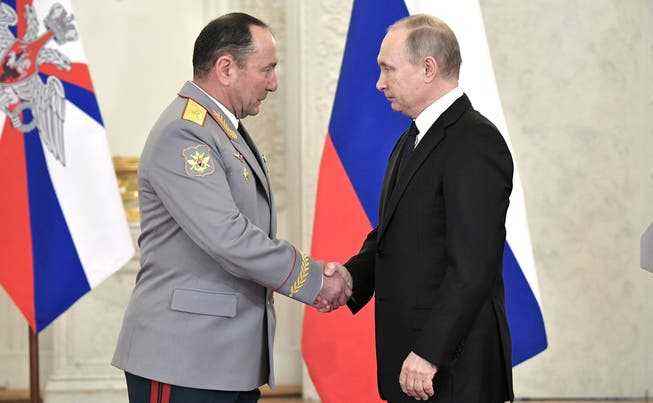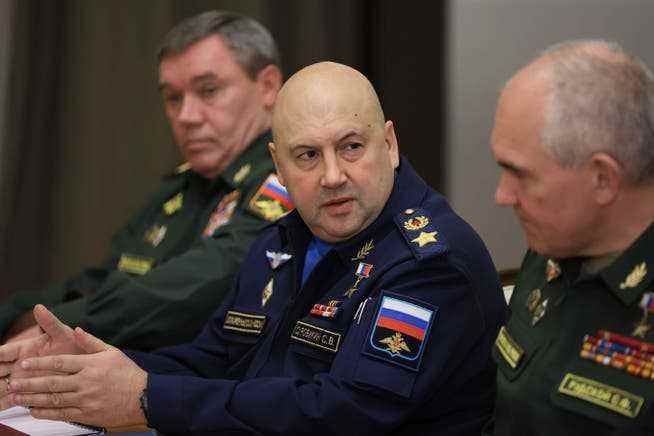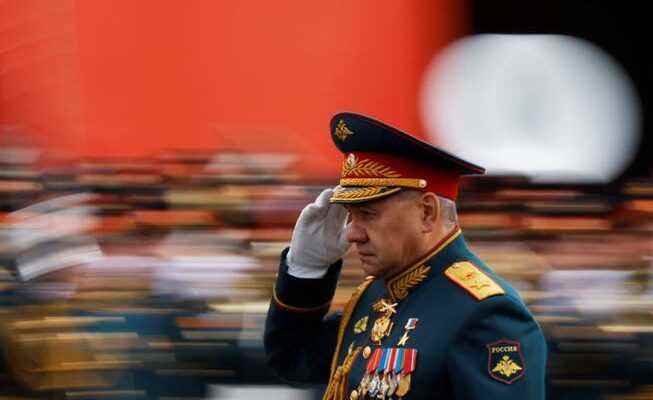The Kremlin has quietly enforced head-rolling among the generals and created a new command structure. Putin is obviously dissatisfied with the course of the war in Ukraine, otherwise he wouldn’t be replacing his generals in such rapid succession.
Russian Defense Minister Sergei Shoigu pictured May 9 inspecting a military parade in Red Square.
Outsiders can often only tell who is in the favor of Russian President Putin by looking at small details. In the Soviet era, Kremlin scientists pored over dry official pronouncements to gain insights into the prevailing balance of power. When an official stood surprisingly close to the leader of the Communist Party at the October Revolution anniversary celebrations, it was taken as a sure sign of his advancement.
Something similar is currently taking place in the war against Ukraine. Russia’s military command structure has been a mystery for months. Moscow reveals only in bits and pieces who the most important commanders are. One such moment came this weekend when the Russian Defense Ministry shed some light with a public statement and a somewhat bizarre video.
A new man at the helm
The confusingly edited and largely silent video shows Defense Minister Sergei Shoigu visiting troops in Ukraine. This alone is remarkable because, as far as is known, this is Schoigu’s first trip to the occupied territories. It is surprising that he waited a full quarter of a year to do so – one would have expected more presence from the responsible minister. The video shows him gesticulating and in the pose of the austere manager. After Shoigu had disappeared from the scene for a long time at the beginning of the war, his communications consultants probably wanted to show him as a man who had everything under control.
Rather casually, but certainly not by accident, an officer appears in the video who had not previously made an official appearance in Ukraine: Colonel General Gennady Shidko. The fact that he sat at the head of the table with Shoigu at the briefing is taken by military experts as evidence that Zhidko is the new overall commander of all troops in Ukraine. The first rumors about Schidko’s promotion had already been circulating a month ago. He replaces General Alexander Dvornikov, who held the post for less than two months.

The alleged new supreme commander in Ukraine, Gennady Shidko, in a picture from 2017, when President Putin honored him with the order “Hero of Russia” in the Kremlin.
Like Dwornikov, Schidko gained combat experience in a leading role in Syria a few years ago. Most recently he served in Moscow with the rank of deputy minister. The rapid reshuffle is proof that the poor performance of the Russian armed forces in Ukraine is not an invention of Western observers, but that there is also dissatisfaction in the Kremlin.
This conclusion is obvious because Putin has made much more extensive changes in appointments. The commander of the airborne troops, Andrei Serdyukov, was apparently dismissed with disgrace. The fact that the highly-decorated Colonel-General is vacating his post was also only casually revealed to the public: last week the state media showed his successor, Mikhail Teplinsky, handing out medals and, as a matter of course, described him as the head of the airborne units. Since this elite force failed miserably in the attack on Kyiv and suffered enormous losses, the change in leadership comes as no surprise.
Towards a more streamlined command structure
Putin has also overhauled the command structure for warfare. This emerges from cryptic official communications from Saturday. According to these, warfare is now the responsibility of two prominent groups, “South” and “Center”. This does not mean the region where they operate, but the origin of the majority of their troops.
At the start of the war, Moscow had given each of the country’s four major military districts responsibility for a sector of the front – west, south, center and east. However, the troops from the western and eastern military districts now seem to have to submit to the two groups mentioned. This can also be interpreted as a consequence of their inadequate performance. For example, while the Western Military District’s armies, which had been hyped for years, had to abandon their attacks on Kharkiv and Sumi without success, the Southern Military District’s troops have taken more territory than anyone else.
The creation of the “South” and “Center” groups is a step towards a more streamlined command structure, but the necessary homogeneity is still lacking. The rivalries between the regional military administrations and their weaknesses in operating together will not simply go away.
It is interesting who is commanding the two groups: As was officially announced for the first time, it is Colonel-General Alexander Lapin for the “Center” and General Sergei Surovikin for the “South” group. They are now, to all appearances, directly under the supreme command of Shidko. All three have in common that they previously served at times as commander-in-chief or chief of staff of the troops in Syria. Participation in a leading role in that absolutely ruthless war to save the Syrian dictator Bashar Asad has long appeared as a prerequisite for rising to the highest ranks in Russia’s military.
Of this trio, Lapin is the only one who has commanded part of the invading forces since the beginning of the war in Ukraine and has been able to hold on in this role despite the recent “purges” in the generals. The Kremlin could have tied a rope of failures in Ukraine to him, too, as head of the central military district, which stretches from the Volga all the way to Siberia. Thus, Lapin’s troops on the march to Kyiv got stuck halfway near Chernihiv. The general can also be accused of nepotism: A video showed him in April pinning a medal to his son’s chest, even though he had lost about half his tanks as a regiment commander.

General Sergei Surovikin (middle), the new head of the armed forces group “South” in Ukraine.
Interesting is the appointment of General Surovikin as commander of the “South” group. Surovikin was previously the head of the Russian Air and Space Forces. The fact that the Luftwaffe also failed to live up to expectations in the Ukraine war didn’t hurt his career. The reason is probably that Surovikin originally does not come from the Luftwaffe, but is an infantry officer. So he has the right profile for his new role.
One detail stands out in his biography, which was shaped by war operations in Afghanistan, Chechnya and Syria: twice in the course of his career he ended up in the mills of the judiciary. In 1991, he was held in custody for a few months because, as a young captain, he commanded a company during the putsch of orthodox communists against the Soviet leadership in Moscow, which clashed with pro-democracy demonstrators, killing three people. In 1995 he was sentenced to a suspended prison sentence for illegal arms sales, but was later rehabilitated.
